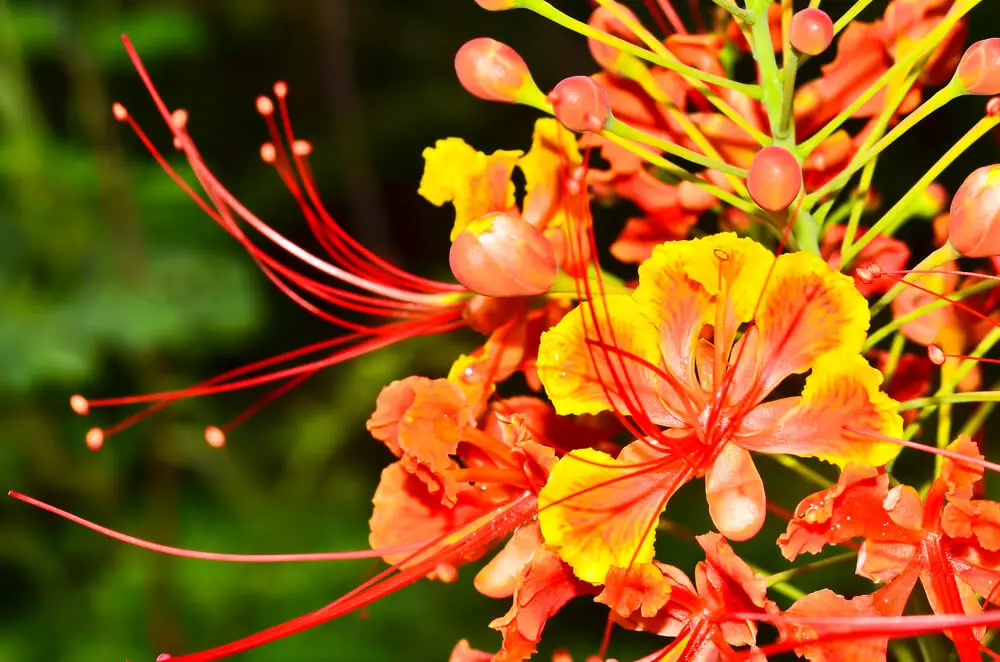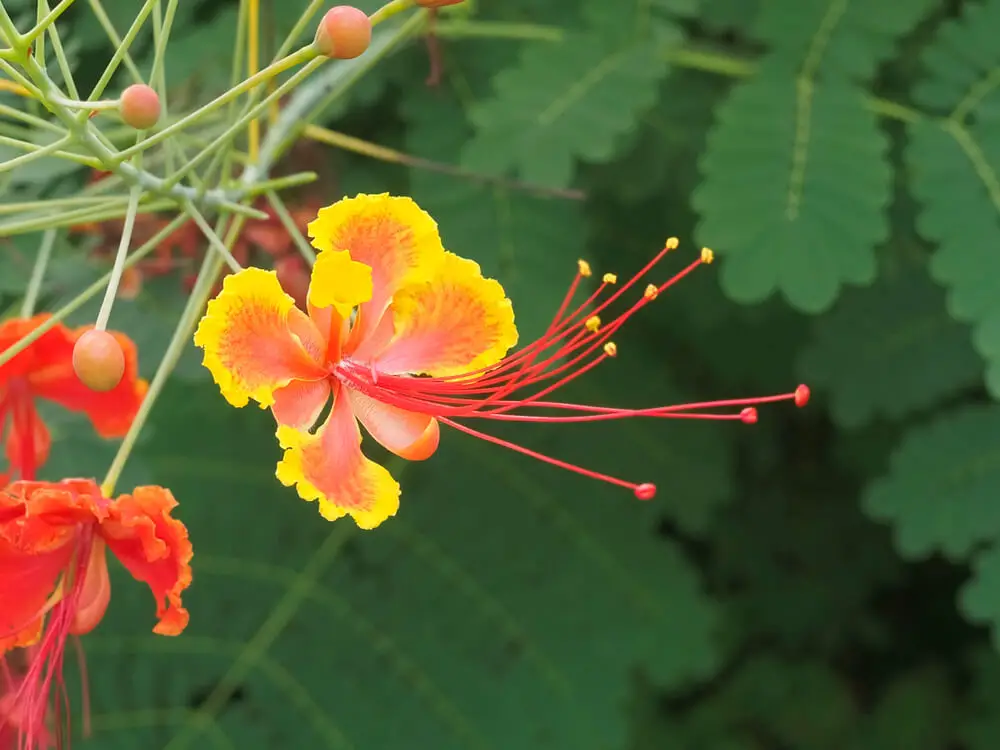The Pride of Barbados is a spectacular plant with flowers that have soothing colors. We understand how distressed you may feel when you notice its leaves are turning yellow.
But how do you cure “Pride of Barbados” yellow leaves?
Yellow leaves in Pride of Barbados are mainly caused by overwatering or underwatering. Watering the plant in the appropriate amount, exposing the plant to enough sun, and providing it with enough nutrients are the primary methods that will help the plant heal. Furthermore, you need to trim back some parts of the plant so it can reserve some of the energy and focus on healing.
In this article, we will be focusing on the reason, the solution, and the prevention of yellow leaves on the Pride of Barbados plants.
5 Reasons & Solutions to Pride of Barbados Yellow Leaves
Yellowing leaves can be caused by several factors, including overwatering or underwatering, a lack of sunlight, nutrient deficiencies, and temperature changes.
The reasons resemble the snake plant having yellow leaves. Let’s take a look at the symptoms and solutions for yellowing leaves.
| Reasons | Symptoms | Solution |
| Overwatering | Damaged root, the odor of decay, wet soil | Repot the plant |
| Underwatering | Dry brittle, crisp root, solid clay | Water properly |
| Not Getting the Right Temperature | Reduced plant vigor, wilted leaves | Adjust the thermostat |
| Not Getting Enough Sun | Dry and wilted leaves | Use a grow light |
| Insufficient Nutrition | Dry and wilted leaves | Use fertilizer |
Reason One: Overwatering
Yellow leaves on plants can be a result of overwatering. But how do you know if your plant is overwatered?
Other than yellowing leaves, the soil would still be wet from the previous watering session. Also, if the roots are rotting, there will be a decaying smell from the root. The stems may become squishy, and the soil would attract pests.
Root rots in the Pride of Barbados can be fatal, and in some cases, they may not be reversible. But your plant may recover if you can detect it in the early stages.
Solution:
Check the plants’ roots if they are white and crisp, there is no root rot. In that case, let the soil dry up before watering any more. Look for up to four inches of dry soil before watering again.
If the roots are turning brown, wrinkled, and squishy, the damage has been done. You can still save the plant. Follow the method prescribed below for the recovery attempt.
- Cut all affected roots back with clean pruning shears.
- Keep the blade disinfected between cuts to prevent the spread of infection.
- Repot your Pride of Barbados into a new pot. Repot your plants in a clean, diluted bleach solution if you have to use the old pot. For the solution, mix 1 cup of bleach in 1 gallon of water together.
If you need help repotting the plant, here is a video you can watch.
Keep an eye on your Pride of Barbados. It will be shocked by the severe root pruning you did, but if you’re lucky, it will bounce back soon. If your plant is in transplant shock, you need to take special care of it for a few days.
Reason Two: Underwatering
Underwatering your Pride of Barbados can put the plant under stress. So, watering the plant with an appropriate amount is crucial for its survival. Dry brittle, crisp roots and solid clay are signs that you’re plants are underwatered.
Solution:
In the first growing season for Pride of Barbados, the plants require watering every day, depending on the rainfall in your area. It should be sufficient to have a slow flow of water trickling for one hour every day.
To ensure the plant is getting the proper amount of water, you need to determine the soil moisture level. Use your finger or a hand trowel to dig a small hole and see if the soil is dry up to 2-4 inches in. If so, you can water the plant.
During hot weather, it is better to thoroughly soak the ground to a depth of 8 inches every few days rather than watering a little bit daily. The roots grow deeper as the plant grows stronger and can withstand droughts.
It is important to monitor new plants for their moisture needs during the first two years to ensure they are getting enough water. Once the plants are strong enough to survive on their own, they should be able to survive without any assistance.
Reason Three: Not Getting the Right Temperature
If watering is not the issue, it could be because the plant is not getting the right temperature.
The pride of barbados is sensitive to the changes in temperature for being from semi-tropical regions. Ideally, they should be kept between 65 and 80 degrees Fahrenheit. If it’s too hot or too cold, your plants will lose their vigor and become wilted.
Solution:
Because of the region you live in, your home may struggle to maintain the temperatures needed for the Pride of Barbados to grow. You can correct this by adjusting your thermostat to the right temperature, which is 65-80 degrees Fahrenheit. You can also move your plant away from any hot or cold drafts if that is not the case.

Reason Four: Not Getting Enough Sun
When kept indoors, Pride of Barbados needs direct sunlight for at least 6 hours a day. If it doesn’t get that, it may suffer from stress. Besides turning yellow, the leaves will become wilted and dry.
Solution:
Make sure the pride of Barbados faces a west- or south-facing window. For people who live in apartments or in northern regions without much sunlight, grow lights are becoming increasingly popular.
These lamps or bulbs produce a light spectrum similar to that found in the sun. While they aren’t a perfect solution for low-light homes, they can help make up for any deficit that causes your Pride of Barbados to fade.
Reason Five: Insufficient Nutrition
If none of the above methods work, the problem may be caused by nutrient deficiencies. The pride of Barbados requires proper nutrients to grow. The soil depletes nutrients over time, so it is crucial to replenish the soil regularly. Dry, wilted leaves are a sign of nutrition deficiency in the plant.
Solution:
Using nitrogen fertilizer is a great way to accomplish this. In general, Pride of Paradise plants need to be fertilized once every month in a 10-10-10 ratio. Follow the amount and application methods instructed on the fertilizer packaging.
You can adjust the amount and frequency based on how the plant responds. But be careful with how much you fertilize. Over-fertilizing can damage the roots, which can be irreparable.
Whenever you are unsure, dilute the mixture to half-strength. You can always add more fertilizer later, but it can be difficult to undo the damage caused by too much fertilizer which can harm the roots.
How to Prevent Yellow Leaves on Pride of Barbados?

Yellow leaves in Pride of Paradise are caused by a lack of care and attention. So, if you know how to take proper care of your Pride of Barbados tree, it can grow quite strong.
The Pride of Paradise trees are drought-resistant once they are established. If properly cared for, the plants will grow on their own.
Soil Type:
Pride of Barbados plants can grow in poor, sandy soils without any special fertilization. They are fine in acidic, neutral, or alkaline soils, as the plant is quite robust.
Proper soil drainage is required for the plants so the water can be drained quickly from the roots. If the soil in your area is too heavy to drain quickly, use a container to grow the plant.
If you wish to grow these plants in soil or peat-based potting mixes, make sure they contain sand, perlite, and vermiculite so that rapid drainage can be achieved. A 16×16-inch container with drainage holes at the bottom is ideal.
Watering:
For the first year or two after planting, Pride of Barbados plants require deep watering once or twice a week. As soon as they are well established, they should not need supplemental watering since they are extremely drought-tolerant.
However, to guarantee the best growth and blooming, deep watering is recommended during prolonged droughts. Deep watering can help the plant be more tolerant of drought as the root can grow deep into the soil. Make sure you water the plants 6-12 inches deep where the stem and drip line is below the outer edge of the branches six to twelve inches deep.
If your plant is grown in a container. Simply water them once or twice each week during the spring, summer, and fall. Make sure the soil is comparatively drier during the winter.
Light and Temperature:
A Pride of Barbados plant requires six to eight hours of direct sunlight each day. They can grow successfully with as little as two hours of direct sunlight, but they are at their best in full sunlight and bloom more profusely.
Plants grown in containers should receive the same amount of sunlight exposure as their ground-grown counterparts. If you move container-grown plants indoors over the winter, place them by a window that receives direct sunlight.
Fertilizing and Pruning:
In early spring, a nitrogen fertilizer diluted to half-strength can be applied to give the plant a boost. However, this is only necessary if the soil is nutrient-poor. It’s important to remember to apply fertilizer immediately after watering or a good rain, but never on dry soil or potting mix.
It’s important to avoid over-fertilizing, which can lead to reduced blooms.
To encourage new growth, prune the branches back by 1 1/2 to 2 feet between October and December.
Mulching:
Mulching is a common horticultural practice that involves spreading a layer of organic or inorganic material over the soil surface. The main purpose of mulching is to improve soil fertility and plant health by conserving soil moisture, controlling weed growth, and regulating soil temperature.
Spread 2 to 3 inches of organic mulch around Pride of Barbados plants grown in the ground, covering the entire root zone. To prevent bark damage caused by excessive, prolonged moisture exposure, keep the mulch 6 inches away from the stems or trunk.
Frequently Asked Questions (FAQs):
Can a yellow leaf turn green again?
Yes, it is possible to turn yellow leaves back to green, but only if they were caused by nutrition deficiencies in the first place. In general, when the leaf loses its chlorophyll, it cannot go back to its former state.
When to plant pride in Barbados seeds?
Spring and early summer are the best times to plant Pride of Barbados seeds. The plant needs full exposure to the sun to grow and thrive.
Should leaves turn yellow during flowering?
Yes, the leaves may turn slightly yellow during the flowering season as the plants divert most of their energy toward the flowers. Also, leaves turn yellow and fall off branches when flushing occurs toward the end of the flowering phase.
Conclusion
Pride of Barbados having yellow leaves is a common issue that can be caused by several factors, such as drought, over-fertilization, and malnutrition.
To keep the plant healthy, it is important to monitor its water and nutrient requirements and to address any potential health issues promptly. With proper care, the Pride of Barbados can continue to flourish and add vibrant color to any landscape.
- Why Are There Still No Tomatoes in My Tomato Plants? Let’s Fix the Issue! - July 13, 2023
- Water Propagation White Stuff on Roots: Everything You Should Know! - July 11, 2023
- String of Dolphins Drying Up: Solved! - July 11, 2023

Pingback: No More Marigold Transplant Shock! [4 Tips for Cure]
Pingback: 7 Major Issues To Solve the Kiwi Issai Problems